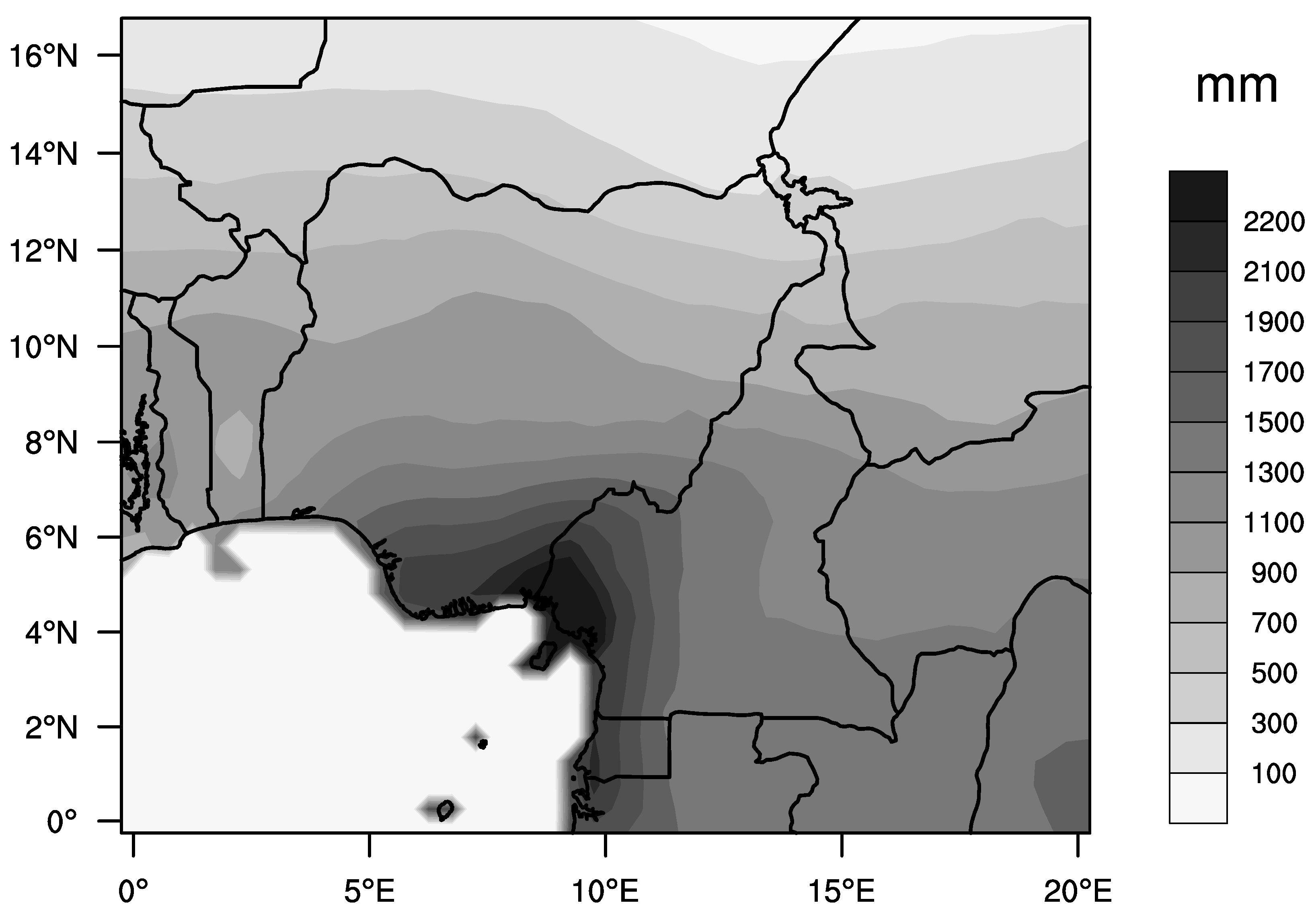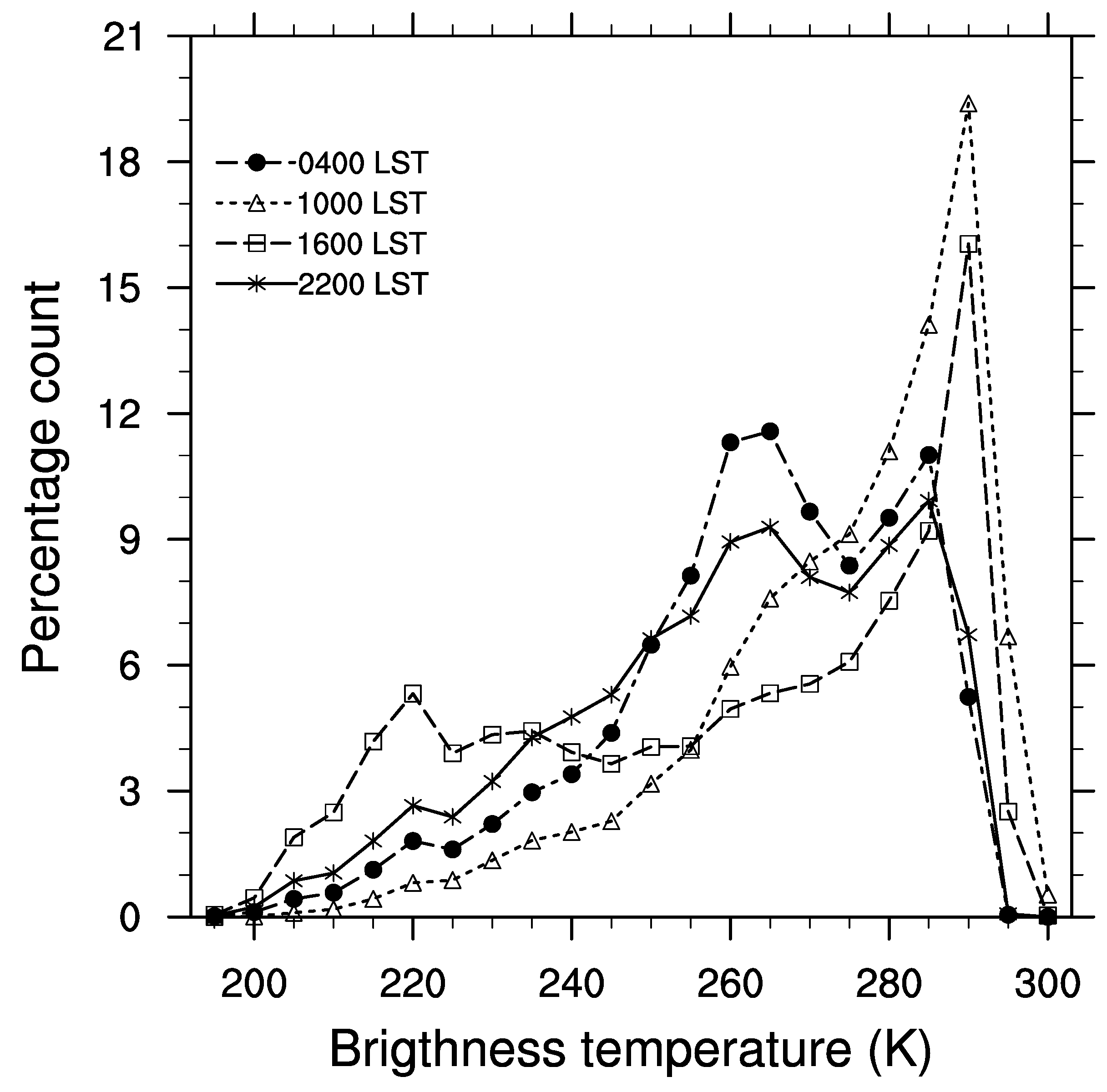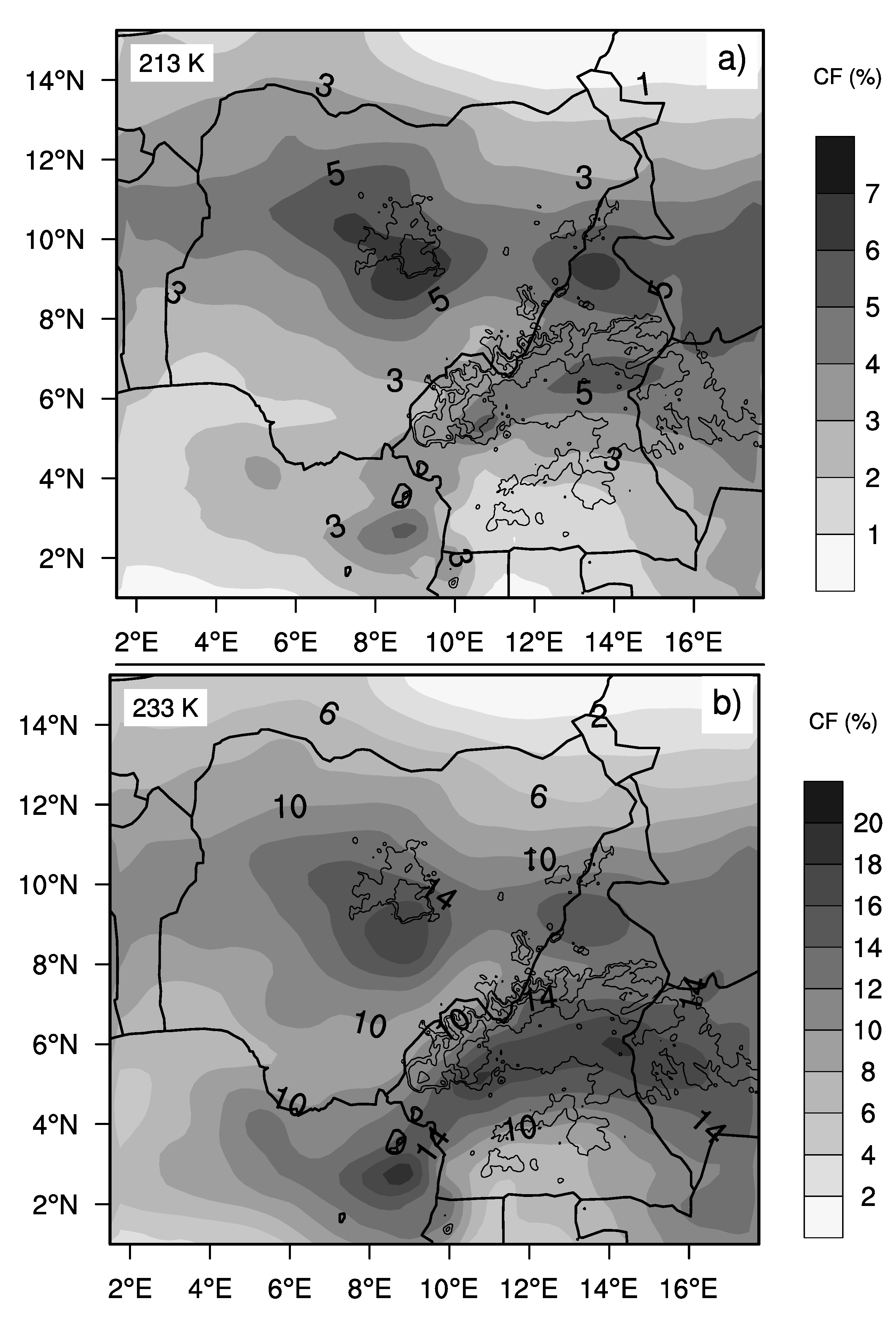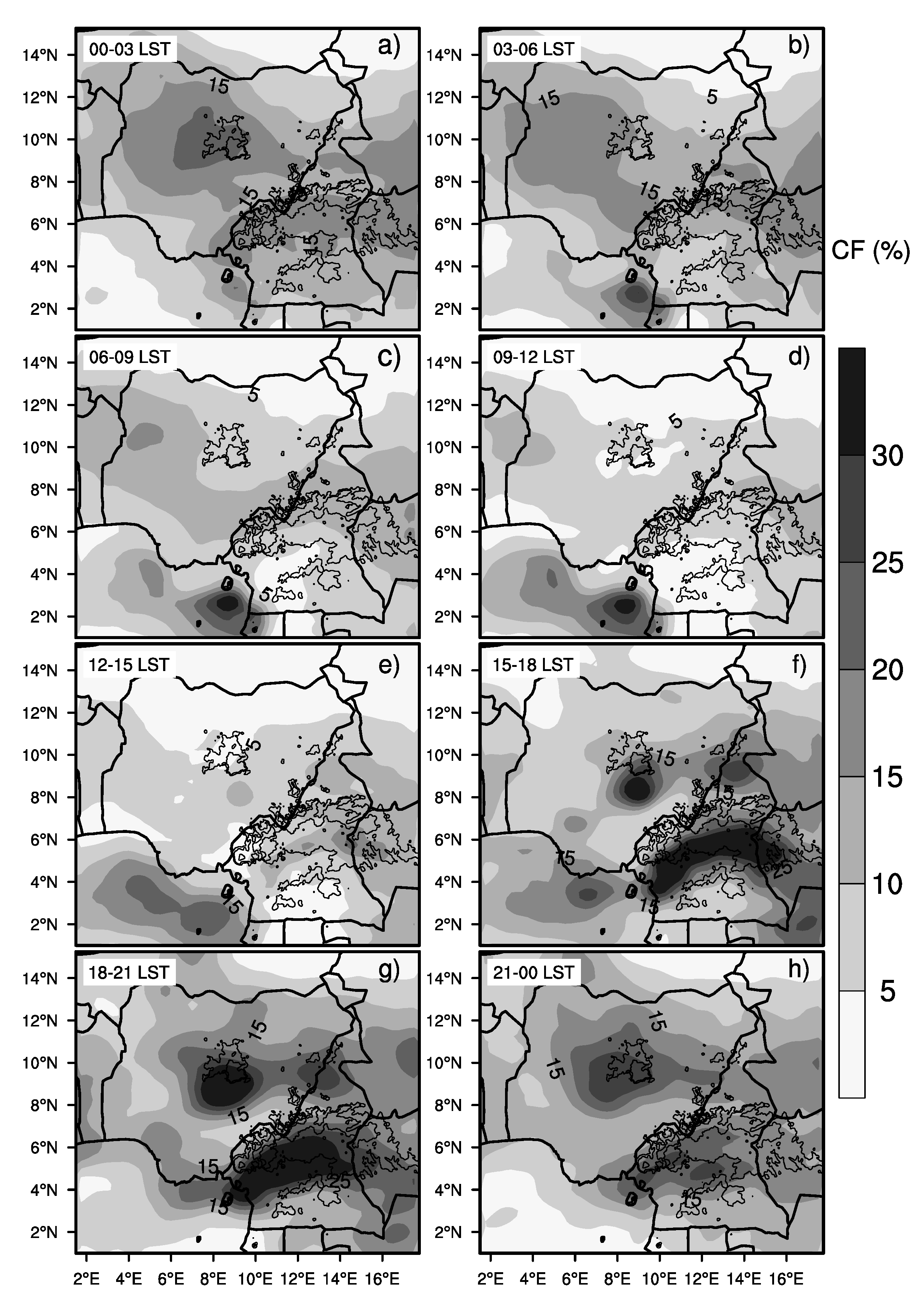Spatio-Temporal Variability of Western Central African Convection from Infrared Observations
Abstract
:1. Introduction
2. Description of the Study Area and the Data Used
2.1. Study Area



2.2. Data Used
3. Identification of Convective Activity
3.1. Determination of the Convection Index

3.2. Evolution of Cloud Coverage

3.3. Mean Spatial Field of Cloud Fraction


 , N are respectively cloud fraction at time t, mean daily cloud fraction and number of image per day. The standard deviation calculated in each grid point is averaged for three months JJA 1998-2002 and portrayed in Figure 6.
, N are respectively cloud fraction at time t, mean daily cloud fraction and number of image per day. The standard deviation calculated in each grid point is averaged for three months JJA 1998-2002 and portrayed in Figure 6. 
4. Diurnal Cycle of Convective Activity
| Region | Temperature range (K) | |||
|---|---|---|---|---|
| 230–235 | 210–220 | 250–260 | 263–283 | |
| 1 (Sahel) | 20:30 | –3:30 | +05:00 | +06:00 |
| 2 (Savanna) | 20:00 | –3:30 | +04:00 | +06:30 |
| 3 (Niger Valley) | 18:30 | –01:00 | +08:00 | +11:30 |
| 4 (Highlands) | 18:00 | –02:30 | +08:30 | +12:30 |
| 5 (Ocean) | 12:30 | –03:00 | +10:30 | +13:30 |
| 6 (Forest) | 17:30 | –1:30 | +07:30 | +12:00 |
4.1. Spatial Patterns of Diurnal Cycle

4.2. Regional Distributions


5. Summary and Conclusions
Acknowledgments
References
- Mathon, V.; Laurent, H.; Lebel, T. Mesoscale convective system rainfall in the sahel. J. Appl. Meteorol. 2002, 41, 1081–1092. [Google Scholar] [CrossRef]
- Gettelman, A.; Salby, M.L.; Sassi, F. The distribution and influence of convection in the tropical tropopause region. J. Geophys. Res. 2002, 107. [Google Scholar]
- Betts, A.K.; Jakob, C. Study of diurnal cycle of convective precipitation over Amazonia using a single column model. J. Geophys. Res. 2002, 107. [Google Scholar]
- Dai, A.; Trenberth, K.E. The diurnal cycle and its depiction in the community climate system model. J. Clim. 2004, 17, 930–951. [Google Scholar] [CrossRef]
- Tchotchou, L.A.D.; Mkankam, K.F. Sensitivity of the simulated African monsoon of summers 1993 and 1999 to convective parameterization schemes in RegCM3. Theor. Appl. Climatol. 2010, 100, 207–220. [Google Scholar] [CrossRef]
- Lee, M.I.; Schubert, S.D.; Suarez, M.J.; Bell, T.L.; Kim, K.M. Diurnal cycle of precipitation in the NASA seasonal to interannual prediction project atmospheric general circulation model. J. Geophys. Res. 2007, 112. [Google Scholar]
- Yang, G.Y.; Slingo, J. The diurnal cycle in the tropics. Mon. Weather Rev. 2001, 129, 784–801. [Google Scholar] [CrossRef]
- Zhou, L.; Wang, Y. Tropical rainfall measuring mission observation and regional model study of precipitation diurnal cycle in the New Guinean region. J. Geophys. Res. 2006, 111. [Google Scholar]
- Garreaud, R.D.; Wallace, J.M. The diurnal march of convective cloudiness over the Americas. Mon. Weather Rev. 1997, 125, 3157–3371. [Google Scholar] [CrossRef]
- Desbois, M.; Kayiranga, T.; Gnamien, B.; Guessous, S.; Picon, L. Characterization of some elements of the sahelian climate and their interannual variations for July 1983, 1984 and 1985 from the analysis of METEOSAT ISCCP data. J. Clim. 1988, 1, 867–904. [Google Scholar] [CrossRef]
- Duvel, J.P. Convection over tropical Africa and the atlantic ocean during northern summer. Part I: Interannual and diurnal variations. Mon. Weather Rev. 1989, 117, 2782–2799. [Google Scholar] [CrossRef]
- Ba, M.B.; Nicholson, S.E. Analysis of convective activity and its relationship to the rainfall over the rift valley lakes of east Africa during 1983–90 using the meteosat infrared channel. J. Appl. Meteorol. 1998, 37, 1250–1264. [Google Scholar] [CrossRef]
- Machado, L.A.T.; Duvel, J.P. Structural characteristics of deep convective systems over Tropcal Africa and Atlantic Ocean. Mon. Weather Rev. 1991, 120, 392–406. [Google Scholar]
- Berges, J.; Jobard, I.; Chopin, F.; Roca, R. EPSAT-SG: A satellite method for precipitation estimation; Its concepts and implementation for the AMMA experiment. Ann. Geophys. 2010, 28, 289–308. [Google Scholar] [CrossRef] [Green Version]
- Chadwick, R.S.; Grimes, D.I.F.; Saunders, R.W.; Francis, P.N.; Blackmore, T.A. The TAMORA algorithm: Satellite rainfall estimates over West Africa using multi-spectral SEVIRI data. Adv. Geosci. 2010, 25, 3–9. [Google Scholar] [CrossRef]
- Reed, R.J.; Jaffe, K.D. Diurnal variation of summer convection over west Africa and the tropical Eastern Atlantic during 1974 and 1978. Mon. Weather Rev. 1981, 109, 2527–2534. [Google Scholar] [CrossRef]
- Parker, D.J.; Burton, R.R.; Diongue-Niang, A.; Ellis, R.J.; Felton, M.; Taylor, C.M.; Thorncroft, C.D.; Bessemoulin, P.; Tompkins, A.M. The diurnal cycle of the west African monsoon circulation. Q. J. R. Meteorol. Soc. 2005, 131, 2839–2860. [Google Scholar] [CrossRef]
- Sall, S.M.; Viltard, A.; Sauvageot, H. Rainfall distribution over the Fouta Djallon–Guinea. Atmos. Res. 2007. [Google Scholar]
- Suchel, J.B.
- Mkankam, K.F.; Tsalefac, M.; Mbane, C.B. Variabilit´e pluviometrique sur le territoire Camerounais: Essai de regionalisation a partir des cumuls mensuels et du cycle annuel. Publ. Assoc. Int. Climatol. 1994, 7, 439–446. [Google Scholar]
- Penlap, K.E.; Matulla, C.; von Storch, H.; Mkankam, K.F. Downscaling of GCM scenarios to assess precipitation changes in the little rainy season (March–June) in Cameroon. Clim. Res. 2004, 26, 85–96. [Google Scholar] [CrossRef]
- Bennartz, R.; Schroeder, M. Convective activity over Africa and the tropical Atlantic inferred from 20 years of geostationary meteosat infrared observations. J. Clim. 2012, 25, 156–169. [Google Scholar] [CrossRef]
- Laing, A.G.; Carbone, R.E.; Levizzani, V. Cycles and propagation of deep convection over equatorial Africa. Mon. Weather Rev. 2011, 139, 2832–2853. [Google Scholar] [CrossRef]
- Hong, G.; Heygster, G.; Rodriguez, C.A.M. Effect of cirrus clouds on the diurnal cycle of tropical deep convective clouds. J. Geophys. Res. 2006, 111. [Google Scholar]
- Tian, B.; Soden, J., Brian; Wu, X. Diurnal cycle of convection, clouds, and water vapor in the tropical upper troposphere: Satellites versus a general circulation model. J. Geophys. Res. 2004, 109. [Google Scholar]
- Zuidema, P. Convective clouds over the bay of Bengal. Mon. Weather Rev. 2003, 131, 780–798. [Google Scholar] [CrossRef]
- Levizzani, V.; Bauer, P.; Turk, F.J. Measuring Precipitation from Space—EURAINSAT and the Future; Springer: Dordrecht, The Netherlands, 2007; Volume 28, p. 722. [Google Scholar]
- Goyens, C.; Lauwaet, D.; Schr¨oder, M.; Demuzere, M.; van Lipziga, N.P.M. Tracking mesoscale convective systems in the Sahel: Relation between cloud parameters and precipitation. Int. J. Climatol. 2011. [Google Scholar]
- Machado, L.A.T.; Laurent, H. The convective system area expansion over amazonia and its relationships with convective system life and high-level wind divergence. Mon. Weather Rev. 2002, 132, 714–724. [Google Scholar]
- Mohr, K.I.; Thorncroft, C.D. Intense convective systems in west Africa and their relationship to the African easterly jet. Q. J. R. Meteorol. Soc. 2006, 132, 163–176. [Google Scholar] [CrossRef]
- Shinoda, M.; Okatani, T.; Saloum, M. Diurnal variations of rainfall over Niger in the west African Sahel: A comparison between wet and drought years. Int. J. Climatol. 1999, 19, 81–94. [Google Scholar]
- Vondou, D.A.; Nzeukou, A.; Lenouo, A.; Mkankam Kamga, F. Seasonal variations in the diurnal patterns of convection in Cameroon–Nigeria and their neighboring areas. Atmos. Sci. Lett. 2010, 11, 290–300. [Google Scholar] [CrossRef]
- Nesbitt, S.W.; Cipelli, R.; Rutledge, S.A. Storm morphology and rainfall characteristics of TRMM precipitation features. Mon. Weather Rev. 2006, 134, 2702–2721. [Google Scholar]
- Schumacher, C.; Houze, R.A., Jr. Stratiform precipitation production over sub-Saharan Africa and the tropical East Atlantic as observed by TRMM. Q. J. R. Meteorol. Soc. 2006, 132, 2235–2255. [Google Scholar]
- Ba, M.B.; Frouin, R.; Nicholson, S.E. Satellite–derived interannual variability of west African rainfall during 1983-88. J. Appl. Meteorol. 1995, 34, 411–431. [Google Scholar] [CrossRef]
- Randall, D.; Harshvardhan, A.; Dazlich, D.A. Diurnal variability of the hydrologic cycle in a general circulation model. J. Atmos. Sci. 1991, 48, 40–62. [Google Scholar] [CrossRef]
- Gray, W.M.; Jacobson, R.W., Jr. Diurnal variation of deep cumulus convection. Mon. Weather Rev. 1977, 105, 1171–1188. [Google Scholar] [CrossRef]
- Mapes, B.E.; Warner, T.T.; Xu, M. Diurnal patterns of rainfall in Northwestern South America. Part III: Diurnal gravity waves and nocturnal convection offshore. Mon. Weather Rev. 2002, 131, 830–844. [Google Scholar]
- Houze, A.R., Jr. Mesoscale convective systems. Rev. Geophys. 2004, 42. [Google Scholar]
- Lenouo, A.; Monkam, D.; Mkankam Kamga, F. Variability of static stability over west Africa during northern summer 1979–2005. Atmos. Res. 2010, 98, 353–362. [Google Scholar] [CrossRef]
- Garcia-Carreras, L.; Parker, D.J.; Taylor, C.M.; Reeves, C.E.; Murphy, J.G. Impact of mesoscale vegetation heterogeneities on the dynamical and thermodynamic properties of the planetary boundary layer. J. Geophys. Res. 2010, 115. [Google Scholar]
- Laing, A.G.; Carbone, R.; Levizzani, V.; Tuttle, J. The propagation and diurnal cycles of deep convection in northern tropical Africa. Q. J. R. Meteorol. Soc. 2008, 134, 93–109. [Google Scholar] [CrossRef]
- Holton, J.R. An Introduction to Dynamic Meteorology, 3rd ed; Academic Press Inc.: Waltham, MA, USA, 1992; p. 591. [Google Scholar]
- Timouk, F.; Kergoat, L.; Mougin, E.; lloyd, C.R.; Ceschia, E.; Cohard, J.M.; de Rosnay, P.; Hiernaux, P.; Demarez, V.; Taylor, C.M. Response of surface energy balance to water regime and vegetation development in a Sahelian landscape. J. Hydrol. 2009, 375, 178–189. [Google Scholar] [CrossRef] [Green Version]
- Melani, S.; Pasqui, V.; Guarnieri, F.; Antonini, V.; Ortolani, V.; Levizzani, V. Rainfall variability associated with the summer African monsoon: A satellite study. Atmos. Res. 2010, 97, 601–618. [Google Scholar] [CrossRef]
- Redelsperger, J.L.; Diedhiou, A.; Janicot, S.; Sonneville, A.; Thorncroft, C. The International Science Plan for AMMA 2010–2020; Technical Report V2; AMMA: Toulouse, France, 2009. [Google Scholar]
© 2012 by the authors; licensee MDPI, Basel, Switzerland. This article is an open-access article distributed under the terms and conditions of the Creative Commons Attribution license (http://creativecommons.org/licenses/by/3.0/).
Share and Cite
Vondou, D.A. Spatio-Temporal Variability of Western Central African Convection from Infrared Observations. Atmosphere 2012, 3, 377-399. https://doi.org/10.3390/atmos3030377
Vondou DA. Spatio-Temporal Variability of Western Central African Convection from Infrared Observations. Atmosphere. 2012; 3(3):377-399. https://doi.org/10.3390/atmos3030377
Chicago/Turabian StyleVondou, Derbetini A. 2012. "Spatio-Temporal Variability of Western Central African Convection from Infrared Observations" Atmosphere 3, no. 3: 377-399. https://doi.org/10.3390/atmos3030377





